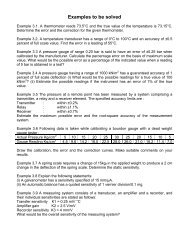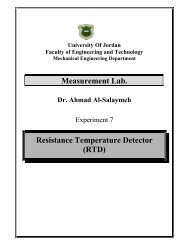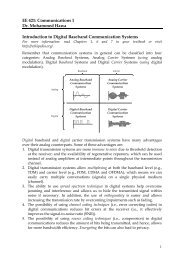Simulation of Third Generation CDMA Systems - Virginia Tech
Simulation of Third Generation CDMA Systems - Virginia Tech
Simulation of Third Generation CDMA Systems - Virginia Tech
Create successful ePaper yourself
Turn your PDF publications into a flip-book with our unique Google optimized e-Paper software.
noise variance is calibrated according to the spreading factor <strong>of</strong> the data channel and the BERis evaluated for the data channel only.Channelization Code(C D )Data (DPDCH)Scrambling Code(C SC )Control (DPCCH)jChannelization Code(C C )Figure 3.2: Desired MSThe channelization codes C D and C C are chosen as described in section 2.4. Thescrambling code is an MS specific long code with a period <strong>of</strong> one frame or 10 ms, asdescribed in section 2.5.3.2.2 Multiple Access InterferenceMAI is implemented by generating the signals for a number <strong>of</strong> interfering MS withinthe system. Each interfering user has its own control channel and one data application. Each<strong>of</strong> the interfering mobile station generates its transmitted frame in the same manner as thedesired user. However these frames are not aligned in time with each other or with that <strong>of</strong> thedesired MS. The maximum <strong>of</strong>fset between the frames <strong>of</strong> an interfering user and that <strong>of</strong> thedesired user can be calculated in the following way:Let the cell radius be D km.The maximum <strong>of</strong>fset between the frames <strong>of</strong> a user and an interferer is the time takenby signal to make a round trip <strong>of</strong> D+D = 2D km. This time is given by30
















